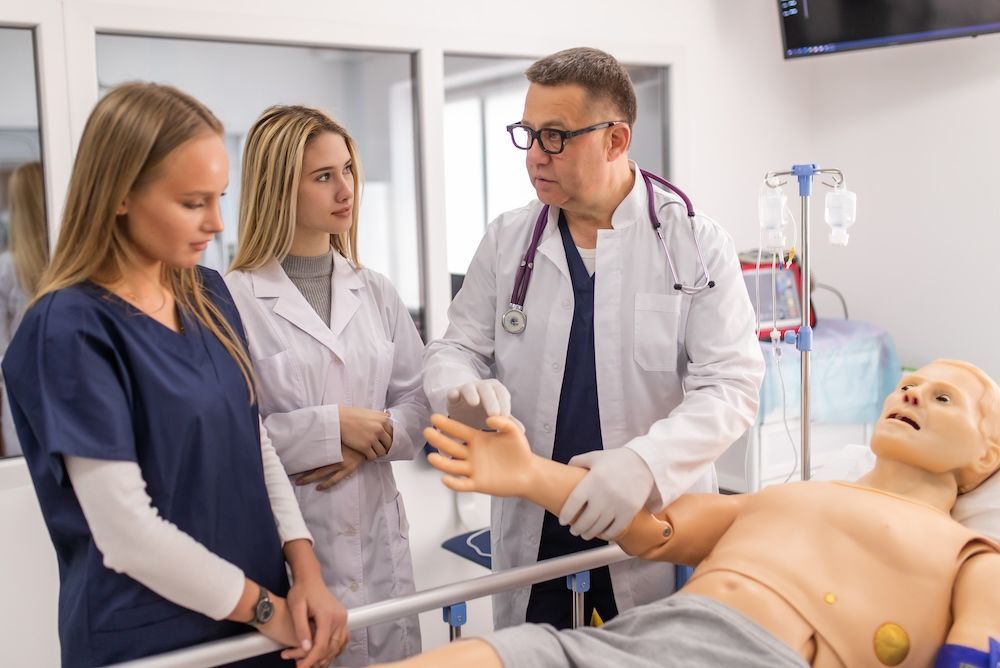How to Overcome Nurse Educator Reluctance to Using Nursing Simulation
Research suggests a lack of some nurse educator’s knowledge and acceptance of the benefits of clinical simulation as an effective student-nurse learning environment. Hands-on experience, time-consuming planning, and a lack of mentoring are common factors that contribute to the reluctance of clinical simulation laboratory usage. This article provides insight into nurse educator barriers to student-nurse clinical simulation utilization. The goal of this HealthySimulation.com article by Barbara Olander BSN, RN, RHIT, is to provide the simulation facilitator with a better understanding of why novice and experienced nurse educators are reluctant to utilize clinical simulation and to recommend interventions to increase student-nurse clinical simulation usage.
Misconceptions and Educators’ Skepticism of Simulation
Identification of novice and experienced nurse educators’ misconceptions and skepticism is the first step to understand the educator’s reluctance for utilization of student-nurse clinical simulation. Inherent or learned misconceptions and skepticism provide insight into needed change within the simulation-based educator environment. One common misconception is that the simulation experience is pretend and not real. Novice and experienced educators demonstrate skepticism and attitudes that are not worth the time and effort needed to plan for clinical simulation, create scenarios, and evaluate student experiences. Research strongly supports that Clinical Simulation is beneficial and necessary for nurse educators to be more effective with student-nurse clinical success.
Sponsored Content:
Just as with student learning, nurse educators must recognize that the simulation experience is characterized by an environment that is experiential, interactive, collaborative, and learner-centered.
Healthcare experience and years of student instruction help guide the simulation scenario development and should reflect the appropriate level of fidelity. Nurse educators must identify and comprehend the application process for each level of simulation fidelity:
- Low-fidelity simulation is used to build knowledge (often the least real to the educator)
- Mid-fidelity simulation is used to build competence (more realistic and allows for increased opportunity for learning)
- High-fidelity simulation is used to build performance and action (allows the most realistic experience and opportunities for learner interaction)
Simulation-based Education (SBE) involves interactive and collaborative learning between a healthcare simulation educator or facilitator and the reluctant nurse educator. Nurse educator engagement, whether a novice educator or an experienced educator, provides an opportunity for the development of clinical simulation scenarios, which often reveals specific rationales of why an educator is reluctant to utilize clinical simulation. Key areas for lack of utilization may include how to incorporate the students’ previously learned clinical skills and critical thinking questions or how to incorporate appropriate use of moulage to ensure realistic sensory experiences.
Explain and identify the types of fidelity so that the reluctant educator will have an opportunity to reflect on and determine the best level of realism for each type of simulation. Types of simulation fidelity include:
Sponsored Content:
- Conceptual fidelity- Ask yourself does the simulation scenario makes sense? Does the simulated patient’s signs and symptoms match the diagnosis?
- Physical fidelity- Does the simulator appear and feel realistic? Increasing the physical fidelity is often beneficial to allow the nurse educator to be the voice of the high-fidelity simulator to promote simulation realism.
- Emotional or psychological fidelity- Does the simulated task feel as real as possible to the student nurse, or feel ‘pretend’? Simulation is not pretend and must reflect actual signs and symptoms, use of medication, and charting in the electronic health record, such as with Lippincott DocuCare. Be an advocate for simulation realism by calling the simulation an “on-campus” clinical versus an “off-campus” clinical, which is at a medical facility.
View the HealthySimulation.com LEARN CE/CME Platform Webinar Simplifying Simulation: Empowering Educators to Deliver Meaningful Experiences to learn more!
Innate Attributes of Educator Reluctance
Innate attributes such as level of anxiety and self-confidence are common factors that affect the nurse educator’s eagerness to incorporate clinical simulation as required by curriculum clinical practice. Below we cover several key areas worthy of consideration:
Level of Anxiety:
- Maintain awareness of the educator’s diverse values, social determinants, and professional roles
- Determine if the anxiety is a perceived knowledge or an actual performance gap. Allow for self-guided reflection and provide feedback.
- Assess the nurse educator’s readiness for simulation learning and integration into clinical experience.
- Maintain and promote mutual respect between the simulation facilitator and nurse educator. Identify and address the educator’s reactions and emotions during discussions.
- Foster a peer relationship and serve as a simulation facilitator mentor to the nurse educator, especially the novice educator.
- Ensure appropriate assignment of simulation fidelity levels to the Knowledge, Skills, and Abilities (KSA) of the novice or experienced educator.
- Coordinate simulation facilitator’s and educator’s schedules to prevent educator avoidance due to discontent with work overload
Self-Confidence:
- Identify the educator’s current medical knowledge, clinical skills, attitudes toward simulation utilization, and prior experiences with simulation. Positive experiences and attitudes promote an increased desire to learn for the nurse educator, which will be noted in positive student-nurse clinical simulation evaluations.
- Identify how a novice or experienced educator’s medical experience aligns with the simulation program’s requirements and needs. Oftentimes the educator’s medical experience does not correlate with the desire to incorporate simulation into the clinical experience. Advocacy inquiry is a conversational technique used to gain insight into another person’s frame of mind and allows for the simulation facilitator and the nurse educator to be transparent about thought processes.
- Novice nurse educators may have limited experience, which requires more simulation facilitator instruction and intervention. Pre-briefing and debriefing experiences must be relevant to the clinical scenario and not reflect personal feelings between the nurse educator and the student nurse. Experienced educators who are familiar with simulation will benefit from the self-driven development of scenarios and simulation approaches.
- Be consistent with the development of objectives, planning of scenarios, and use of templates. The National League for Nursing Simulation Design Template is a free resource for immediate use. NLN Simulation Design Template 2023.
- Encourage educators to develop an electronic clinical simulation scenario folder and explain the need to share usage with other educators.
- Encourage and explore areas of professional development through organizations such as the International Nursing Association for Clinical Simulation and Learning (INACSL), the Society for Simulation in Healthcare (SSH), or Using Virtual Reality for Teaching and Learning in Healthcare Simulation.
Overcoming Barriers Requires Up Front Effort
Simulation facilitators are constantly challenged by novice and experienced nurse educators related to clinical simulation. The simulation facilitator’s focused expertise will identify the nurse educator’s reasons for reluctance, clarify misconceptions and skepticism, and provide the nurse educator with a positive desire to utilize clinical simulation.
Learn More About Becoming a Simulation Nurse Educator!
References:
- Cook, DA, Hatala R, Brydges R, et al. Technology-enhanced simulation for health professions education; a systematic review and meta-analysis. JAMA 2011;306(9):978–88
- Mundell W. Kennedy C, Szostek J, Cook D. Simulation technology for resuscitation training; a systematic review and meta-analysis. Resuscitation 2013;84:1174-1183
- Jeffries, P.R., Rogers, B., & Adamson, K., NLN Jeffries Simulation Theory: Brief Narrative Description, Nursing Education Perspectives, September/October 2015, 36(2), p.292-93
- Increasing Fidelity and Realism in Simulation | Wolters Kluwer
- Harrington, Douglas W., Simon, Leslie V.. Designing a Simulation Scenario.
Barbara Olander is currently the skills and simulation laboratory coordinator for Southwest Mississippi Community College in Summit, MS. With 31 years of extensive nursing experience in healthcare and academic settings, she has a demonstrated work history in clinical care, management, nursing education, policy development, and healthcare simulations. She has degrees in nursing and recently completed the Associate of Applied Science in Health Information Technology. She has six years of experience with simulation usage. She is an ATI Champion, RHIT certified, and recently completed the 25.5 CEU MAST Simulation Foundations Course. She utilizes a variety of simulation learning methods and includes scaffolding to allow student learners to progress from metacognition, self-reflection, and instructor feedback. She believes in applying the principles of simulation education across the spectrum of professional degrees and nursing student programs. Barbara Olander uses her positive attitude and tireless energy to continue simulation education in the areas of virtual healthcare simulation, faculty simulation development, and alternative ways for students to improve simulation experiences. Barbara Olander is a member of the Society for Simulation in Healthcare, Mississippi Nurses Association, National Association of Licensed Practical Nurses, Inc., Mississippi LPN Association, American Health Information Management Association, and Mississippi Health Information Management Association.
Sponsored Content:


















